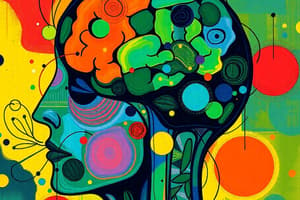Podcast
Questions and Answers
Which of the following is NOT considered an indicator of abnormality?
Which of the following is NOT considered an indicator of abnormality?
- Maladaptiveness
- Statistical deviancy
- Rationality and predictability (correct)
- Subjective distress
The DSM-5 defines a mental disorder as a syndrome involving clinically significant disturbance in which of the following areas?
The DSM-5 defines a mental disorder as a syndrome involving clinically significant disturbance in which of the following areas?
- Behavior
- Emotion regulation
- Cognitive functioning
- All of the above (correct)
What is a primary disadvantage of using classification systems for mental disorders?
What is a primary disadvantage of using classification systems for mental disorders?
- Influences insurance reimbursement
- Provides a common language
- Can lead to stigma and stereotyping (correct)
- Facilitates research
Taijin kyofusho, an anxiety disorder characterized by the fear of offending others, is a culture-specific disorder most commonly found in which culture?
Taijin kyofusho, an anxiety disorder characterized by the fear of offending others, is a culture-specific disorder most commonly found in which culture?
Which term refers to the number of new cases of a disorder occurring over a specific period?
Which term refers to the number of new cases of a disorder occurring over a specific period?
Why might individuals with psychological disorders be treated by their family physician instead of a mental health specialist?
Why might individuals with psychological disorders be treated by their family physician instead of a mental health specialist?
Which mental disorder is identified as resulting in the biggest global burden of disease?
Which mental disorder is identified as resulting in the biggest global burden of disease?
What is the primary goal of deinstitutionalization?
What is the primary goal of deinstitutionalization?
Which mental health professional is primarily responsible for prescribing medications?
Which mental health professional is primarily responsible for prescribing medications?
What is a limitation of case studies?
What is a limitation of case studies?
Which of the following is an example of an observational approach in psychological research?
Which of the following is an example of an observational approach in psychological research?
What is the purpose of a hypothesis in scientific research?
What is the purpose of a hypothesis in scientific research?
What is the primary difference between internal and external validity?
What is the primary difference between internal and external validity?
In research, what is the purpose of a comparison group (control group)?
In research, what is the purpose of a comparison group (control group)?
What does a statistically significant correlation (e.g., p < .05) indicate?
What does a statistically significant correlation (e.g., p < .05) indicate?
Which statement is true regarding correlation and causality?
Which statement is true regarding correlation and causality?
How does prospective research strategy differ from retrospective research strategy?
How does prospective research strategy differ from retrospective research strategy?
In experimental designs, what is the role of random assignment?
In experimental designs, what is the role of random assignment?
What is the purpose of an ABAB design in single-case experimental studies?
What is the purpose of an ABAB design in single-case experimental studies?
Why is it important to monitor proposed expansions of what is considered a "mental disorder?"
Why is it important to monitor proposed expansions of what is considered a "mental disorder?"
Flashcards
Abnormal Psychology
Abnormal Psychology
Focuses on understanding the nature, causes, and treatment of mental disorders.
Subjective Distress
Subjective Distress
Psychological pain or suffering experienced by an individual.
Maladaptiveness
Maladaptiveness
Behavior that interferes with an individual's well-being and ability to function effectively.
Statistical Deviancy
Statistical Deviancy
Signup and view all the flashcards
Violation of Societal Standards
Violation of Societal Standards
Signup and view all the flashcards
Social Discomfort
Social Discomfort
Signup and view all the flashcards
Irrationality and Unpredictability
Irrationality and Unpredictability
Signup and view all the flashcards
Dangerousness
Dangerousness
Signup and view all the flashcards
DSM (Diagnostic and Statistical Manual of Mental Disorders)
DSM (Diagnostic and Statistical Manual of Mental Disorders)
Signup and view all the flashcards
Mental Disorder (DSM-5 Definition)
Mental Disorder (DSM-5 Definition)
Signup and view all the flashcards
Nomenclature (in classification)
Nomenclature (in classification)
Signup and view all the flashcards
Stigma
Stigma
Signup and view all the flashcards
Stereotyping
Stereotyping
Signup and view all the flashcards
Labeling
Labeling
Signup and view all the flashcards
Taijin kyofusho
Taijin kyofusho
Signup and view all the flashcards
Ataque de Nervios
Ataque de Nervios
Signup and view all the flashcards
Epidemiology
Epidemiology
Signup and view all the flashcards
Prevalence
Prevalence
Signup and view all the flashcards
Incidence
Incidence
Signup and view all the flashcards
Comorbidity
Comorbidity
Signup and view all the flashcards
Study Notes
Introduction to Abnormal Psychology
- Abnormal psychology seeks to understand the nature, causes, and treatment of mental disorders
- Mental health is a relevant topic often portrayed in media and present in communities
- Clinicians and researchers require specific skills to address mental disorders using scientific approaches
- Psychologists utilize research to comprehend disorders and improve treatment methods
- Research advancements lead to better understanding and more effective treatments for mental disorders
Defining Abnormality
- A universally accepted definition of abnormality remains elusive
- No single behavior sufficiently defines it
- Difficulties across multiple life areas increase the likelihood of a mental disorder
Indicators of Abnormality
- Subjective distress refers to psychological pain or suffering, and is neither sufficient nor necessary on its own to define abnormality
- Maladaptiveness describes behavior that interferes with well-being and the ability to function effectively
- Statistical deviancy indicates statistically rare behavior, but relies on value judgments
- Violation of the standards of society involves a failure to adhere to social and moral norms
- Social discomfort arises when an individual's behavior creates unease in others
- Irrationality and unpredictability are characterized by erratic or incomprehensible behavior
- Dangerousness relates to the risk posed to oneself or others, though is not always indicative of mental illness
- Decisions about abnormal behavior are always based on the values and expectations of society
DSM-5 Definition of Mental Disorder
- The Diagnostic and Statistical Manual of Mental Disorders (DSM) serves as the standard for defining mental disorders in the U.S.
- The DSM-5 includes 541 diagnostic categories
- Revisions to the DSM are important for incorporating new scientific developments
- DSM-5 defines a mental disorder as a syndrome involving clinically significant disturbances in behavior, emotion regulation, or cognitive functioning, reflecting biological, psychological, or developmental dysfunctions.
- Mental disorders typically cause distress or disability in social, occupational, or other key areas.
- DSM-5 excludes predictable responses to stressors and conflicts with society when defining mental disorders
- Any definition of abnormality involves some degree of arbitrariness
- ICD-10 (International Classification of Diseases) represents another diagnostic system used outside the U.S.
Classification and Diagnosis: Advantages
- Classification systems provide a nomenclature (naming system) for a common language
- Classification structures information and organizes diagnoses
- Classification facilitates research, promotes understanding of causes, and improves treatment approaches
- Classification defines the scope of problems addressed by mental health professionals
- Classification influences insurance reimbursement for psychological difficulties
Classification and Diagnosis: Disadvantages
- A classification system can lead to the loss of individual information
- Classification may cause stigma associated with psychiatric diagnoses
- Classification can result in stereotyping, which involves automatic beliefs about people in a particular culture
- Classification can lead to labeling, where a person's self-concept is affected by receiving a diagnosis
- Stigma deters individuals from seeking treatment
Impact of Culture on Abnormality
- Culture influences how abnormality is defined and presented
- Beliefs and behaviors within a culture are accepted practices
- Variations exist in how different cultures describe psychological distress
- Most psychiatric literature comes from Euro-American countries
Culture-Specific Disorders
- Taijin kyofusho is an anxiety disorder found in Japan involving fear of offending others
- Ataque de nervios is an expression of distress in Latino cultures, involving crying and trembling
- Certain behaviors, like hearing voices or defecating in public, are almost universally considered abnormal
Epidemiology and Its Importance
- Epidemiology is the study of the distribution of diseases, disorders, and health-related behaviors in a population
- Epidemiological info is essential for planning mental health services
- The frequency of mental disorders offers insights into the possible causes
Prevalence and Incidence
- Prevalence indicates the number of active cases in a population during a specific period
- Point prevalence captures the proportion of active cases at a specific point in time
- 1-year prevalence includes anyone experiencing depression at any point during the year
- Lifetime prevalence counts the number of people who have had a disorder at any point in their lives
- Incidence refers to the number of new cases that occur over a set period
Prevalence Estimates for Mental Disorders
- The National Comorbidity Survey Replication (NCS-R) provides prevalence estimates for mental disorders in the US
- About half of American adults have experienced mental illness at some point in their lives
- Anxiety disorders are the most prevalent category of mental disorders
- Major depressive disorder, alcohol abuse, and specific phobias are the most common individual disorders
- Serious mental illness affects about 4.1% of adults
- Comorbidity is the concurrent presence of two or more disorders in the same individual
Treatment Considerations
- Treatments like medication and psychotherapy are available for mental disorders
- Not everyone with a psychological disorder receives treatment
- Stigma can deter people from seeking help
- Individuals often consult their family physician instead of a mental health specialist
Global Burden of Disease and Mental Health
- Mental and substance use disorders account for over 7% of the global burden of disease
- Depression represents the largest single contributor to the global burden of disease
- Mental disorders cause significant economic losses because of decreased productivity
Deinstitutionalization Impact
- Deinstitutionalization represents a trend away from traditional hospitalization
- There are decreases in inpatient beds for mental health treatment
- There is an increase in prison inmates being treated for severe mental illness
- Movement away from long-stay inpatient hospitalization has had many unintended consequences for disadvantaged people
Mental Health Professionals Roles
- Psychiatrists prescribe medication
- Clinical psychologists provide individual therapy
- Clinical social workers help with family problems
- Psychiatric nurses provide support
Reasons for Abnormal Psychology Research
- To understand the specific characteristics of disorders
- To learn about the etiology, or causes, of mental disorders
- To provide patients with the best care possible
- To avoid biases in perception and inference
- Research can be conducted in clinics, hospitals, schools, and prisons
- Research methodology is constantly evolving
Sources of Information
- Psychological knowledge comes from observation
Case Studies
- Detailed accounts of individual patients
- Can illustrate clinical material
- Have low generalizability, meaning they cannot be used to draw conclusions about other cases
- May be biased
Self-Report Data
- Questionnaires and interviews
- People may not accurately report their own subjective states
- Data can be misleading due to factors such as lying or misinterpretation
Observational Approaches
- Collection of data without direct questioning
- Direct observation of behavior
- Collection of biological data, such as heart rate and stress hormones
- Utilization of brain-imaging techniques like fMRI to study brain function
- Clinical research comprises a combination of self-report and observational methods
The Role of Hypotheses
- A hypothesis is an attempt to explain, predict, or explore a phenomenon
- Scientists test their hypotheses through research studies
- Sources of hypotheses may include anecdotal accounts and unexpected research findings
- Hypotheses influence therapeutic approaches for clinical problems
Sampling and Generalization Considerations
- Study groups with similar abnormalities of behavior
- Sampling involves selecting people who are representative of a larger group
- In random sampling, every person has an equal chance of being included
- Researchers sometimes use "samples of convenience"
Internal and External Validity
- External validity refers to the extent to which findings can be generalized beyond the study itself
- Internal validity refers to how confident we are in the results of a study
Criterion and Comparison Groups
- The comparison group, also known as the control group, consists of people who do not exhibit the disorder being studied
- The criterion group consists of people with the disorder being studied
- Researchers compare the criterion and comparison groups on variables of interest
Correlational Research Designs: Associations
- Examines the world as it is without manipulating variables
- Capitalizes on natural groupings of people
- Useful for identifying factors associated with disorders
Measuring Correlation
- Determines associations among phenomena
- Positive correlation occurs when measures vary together in a direct manner
- Negative correlation indicates an inverse relationship between the variables of interest
- The strength of correlation is measured by the correlation coefficient (r)
- Ranges from 0 to 1
- Positive or negative sign indicates the direction of association
Studying That Suits You
Use AI to generate personalized quizzes and flashcards to suit your learning preferences.




